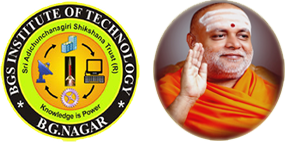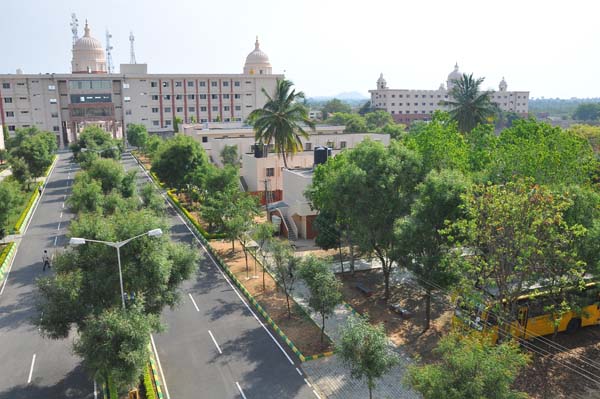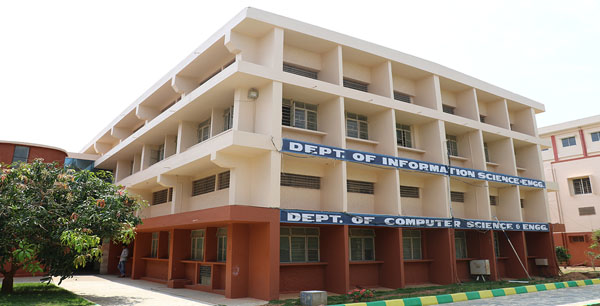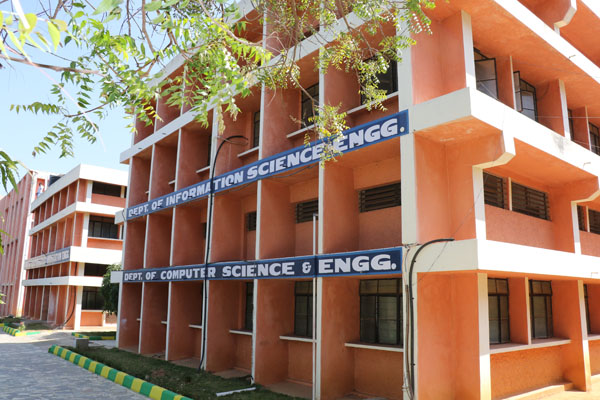- Describe at least two institutional best practices (details of two best practices)
“BGS Institute of Technology is a community that is dedicated for creating tomorrow’s engineers and supporting today’s pioneers”. Quality teaching in higher education is a key factor which contributes in students’ learning and obtaining good results. BGSIT ensures that the education we offer meets the expectations of students and the requirements of employers, both for today and for the future. To be committed on our vision and growth roadmap, we follow a series of practices to ensure that the execution of these practices meets the objectives and outcomes. Our Mission is towards creating students for career success is a seamless process at our institution. B G S Institute of Technology gives its students a rewarding, richly resourced and intellectually inspiring gurukul to pursue their engineering and research.
BGSIT commits on the philosophy of AFFORDABLE & QUALITY Learning for all. Two key aspects to achieve this mission are listed below:
- Quality Teaching: We believe that Quality teaching is a multi- level exertion which yields at three levels: Institution, Course & Individual Level.
- At the Institution Level introducing practices like Faculty Development Programs, Faculty Performance Mapping based on the Student Performance in Academics, Research Papers, Innovative delivery and learning practices, Monthly / Weekly Performance Review Meetings, setting up the Research and Innovation lab in collaboration with Industry Leaders with respect to upcoming job roles and technology are few of the innovative practices followed regularly at BGSIT
- At the Course Level, it comprises an action to measure and optimize the performance, content, delivery methodology, integrations of future learning platforms of the course regularly. Regular meetings are held to understand the course gaps and preventive measures are put in place by Principal, Department Heads and Faculties to curb the gap w.r.to Skills and Outcome of the Course.
- At the Individual Level the driving initiatives to meet HOD’s, Faculties mission, vision and career aims, encouragement to drive towards innovation and adopt a learner oriented focus rather than Teacher centric learning is encouraged.
Benchmarking of these practices is very essential to understand the impact it creates. For this, we have different ratings and mentors within the institutes for not only to evaluate but also to guide professors, HOD’s, and students in achieving the objectives. BGSIT considers Quality Teaching as a premeditated objective to nurture continuous improvement in teaching exercises. This is also achieved by adopting discussion across the institution between various student and faculty teams, institutional audit, publication of international and domestic journals, implementation and revision of educational delivery reforms.
Evidence of Success
BGSIT is continuously securing university ranking in various department such as,
- Reena S - 8th Rank (2009, Information Science)
- Harshitha S -4th Rank, (2009, Medical Electronics)
- Jyothi J- 1st Rank, Topper Of Toppers (2010, Medical Electronics)
- Umesha C.S -1st Rank, Topper Of Toppers (2012, Computer Science)
- Manjushree D.R-6th Rank (2014, Civil Engineering)
-
Introduction &Integration of Technology and Gamification for Student Learning:
At BGSIT, we are constantly striving to create an ecosystem for a student which not only prepares them for current industry expectations but also makes them assertive to stand strong and confidently face the future with the required skills sets. At BGSIT, students constantly learn and use multiple technology platforms to upgrade their knowledge. This helps them to build a deeper connect and understanding of the content being taught. Students at BGSIT not only identify tools, but also obtain information in a timely manner, analyse and synthesize the information to present it professionally for the needed. It is more of an integral part of the system. We make sure that teachers, trainers and students collaborate through technology which is involved in different research and innovative activities. Project Based activities is one of the best practices we follow wherein, students are taught on real time platforms and projects under various mentors assigned to the group during their academics. Vacations at the end of every semester are split into 70:30 ratio where 70% of the vacation is given to students to spend time at home and 30% of the time is utilize constructively to upscale their industry skill sets either in the form of technical or non-technical skill set followed by a real-time project.
Gamification mode of learning is encouraged a lot at BGSIT. Here our faculties constantly evolve new games and activities to make a classroom session not only Teacher Centric but Objective cum Outcome centric. Our internal evaluation online platforms help students to take any amount of self-assessments online either through a Laptop, PC or even a Mobile. Web based projects, Research and Explorations are all seamlessly part of BGSIT Student Learning Eco system. This helps students to develop their thought process in sync with Critical and Logical Think tank and be more independent in self-evaluating the academic and industrial performance.
3. Soft Skill Development Programs
Goal
- To engage participation of students in the planning, decision making, implementation process and to develop the communication skills, interpersonal skills, social skills and other carrier oriented skills
- To achieve maximum placements for students.
- To guide students on various interview techniques, group discussions, aptitude tests.
Context
- Soft Skill Development program will benefit in the overall personality and professional development of the students
- Enabling students to improve overall skill sets
- Awareness among the students about recent technological development in society
- Enable students to conduct innovative experiments
Practices
- Signed MOU’S with TCS and ZESTECH Global Private Limited for continuous learning and development
- Regular training program like soft skills, aptitude skills and personality development will be conducted by TCS- AFFIRMATIVE Action Program (TCS-AAP) and ZESTECH Global Private Limited Bangalore.
Evidence of Success
- Various companies has visited our college such as TATA Consultancy Services, Wipro, NTT DATA, HP, Amazon, Tech Mahindra, Sonata Software, TVS, L&T Infotech, Trigent, Theorem, Quest informatics, Mphasis, Capgemini, Tayana, Spiders so on..
- Huge number of students got Internship opportunity and 631 number of students has Recruited to the visited companies. Recruitment percentage is increasing yearly
4. Digital Library at BGSIT Library and Information Centre
Goal:
- Access to large amounts of information to users wherever they are and whenever they need it.
- Access to primary information sources.
- Support multimedia content along with text.
- Network accessibility on Intranet and Internet.
- User-friendly interface.
- Hypertext links for navigation.
- Client-server architecture.
- Advanced search and retrieval.
- Integration with other digital libraries.
The Context:
- Expedite the systematic development of procedures to collect, store, and organize,
- Information in digital form.
- Promote efficient delivery of information economically to all users.
- Encourage co-operative efforts in research resource, computing, and communication networks.
- Strengthen communication and collaboration between and among educational institutions.
- Take leadership role in the generation and dissemination of knowledge
- The in-built software is widely used for the creation, storage, retrieval and management of bibliographic records and/or indexes. Using this software, record format can be maintained in the database wherein, it provides for authority control/login control, subject titles/volumes etc.
- There are two different interfaces for search engine and retrieval of the catalogue used through the software.
- The in house software allows the admin to maintain the library database (the main cataloguing module), for users, the software allows to search and show the results – through Online Public Access Catalogue (OPAC)
The Practice:
- BGSIT Library & Information Centre (LIC) situated in B G Nagara, Karnataka.
- It was established in the year 2005.
- The college offers Under Graduate and Post Graduate Programmes.
- BGSIT Library & Information Centre has 1350 registered users with collection of 25000 volumes of books,
- Subscribed 79 journals/magazines print version, 1250 CD-ROM’s including books, journals, student’s projects, e-learning etc.
- Library is automated with open source software NewGenLib.
- Implemented all the modules. We provide online access to catalogue.
- Successfully Completed Digital Library (Uploading Questions Papers, Faculty Publication and Important notes and Others) Work.
Module description:
- Material entry module: With this module entry of books is done with all the details of books like book number, name of the book, author, publisher etc.
- Member entry module: All students and faculty member‘s details is added to the database.
- Transaction module: This particular module includes issue of the books and returned date of the books
- Search: The module searches the particular book or member details regarding the books issued or returned.
- Reports: This includes the report of books transactions and used to generate digital accession register.
The evidence of success:
- The students used digitalized library facility extensively to retrieve library information like online access to e-books and other library resources without much difficulty through a mobile application. The complete in house software installation and barcode scanning of books will be done in the departmental library to assist digitalization. Barcode scanning is helpful in digitization and for fast entry of books details in the database.
Problems Encountered and resource required:
- Manual maintenance of books, data and accession register requires more time. The database maintenance of the register is difficult. The report generation fails to possess much accuracy. Hence, the department planned to have separate software in this regard in order to reduce the problem in database maintenance. Resources required are the skilled faculty members to develop and run the software.
Technical architecture
- The first issue is that of the technical architecture that underlies any digital library system. Libraries will need to enhance and upgrade current technical architectures to accommodate digital materials. The architecture will include components such as:
- High-speed local network.
- Relational databases that support a variety of digital formats
- Full text search engines to index and provide access to resources
- Electronic document management functions that will aid in the overall management of digital resources
3 “Student Counselling System”
Goal
- The objectives of the practice are:
- To improve of teacher-student and Institute-Parent relationship.
- To carry out effective Counselling of students to solve their problems and build confidence in them.
- To guide students to choose right career path for job, higher studies, Entrepreneurship etc.
- To improve teaching learning process.
The Context:
- Over a period of last one decade, the institution has noticed several students being detained/ failing in subjects, for want of academic requirements to achieve vertical progression. Further, many students have become drop outs due to lack of awareness about regulations of the programme, lack of interest in the course, personal problems, social and economic problems. Such issues necessitated the college to implement the counselling system.
- The student needs mentoring support to achieve academic excellence.
- The scheme aims at addressing conflicts in attitudes, habits and knowledge of the students towards learning practices.
- Several supporting practices are needed to achieve better coordination of lectures, tutorials and practical classes.
The Practice:
- Institute has an effective counselling system in which 15 to 20 students are assigned to a particular teacher who has to counsel a student in a systematic way.
- Counsellor maintains a progress report of each student. Progress report contains all personal, academic, curricular and other details of the student.
- A student who is assigned to a particular counsellor in the first semester continues to receive counselling from the same counsellor till the student completes the programme.
- Information about the student performance is sent to parents through SMS/by making phone calls/E mails.
- Institute regularly organizes Parents-Teachers Meet where parents can interact with counsellors and course teachers about their ward’s performance.
Evidence of Success
- Student’s attendance has improved after counselling by the counsellors.
- The direct communications between counsellor and students have improved the teacher-student relationship.
- Academic performances of the students have improved.
- Participation in co-curricular and extra-curricular activities has been enhanced as counsellor guides the student about these activities.
- Parent-institution relationship is strengthened and the parents are happy with this practice.
- Students become more disciplined.
Problems Encountered and Resources Required.
- Whenever there is a staff turnover, training for the new staff to the existing system and effective implementation is a real challenge. In view of this, the newly joined faculty members who are not accustomed with this program are trained by the institute to take up student counselling work.
- Parents find difficulty to get information about their wards and contact details of the counsellor, when the student counsellor changes because of staff turnover.
- HODs encounter with problems to allocate the counsellor for year back students.
- Apart from regular workload, allocating sufficient time for one to one student interaction becomes difficult task for the faculty members.












